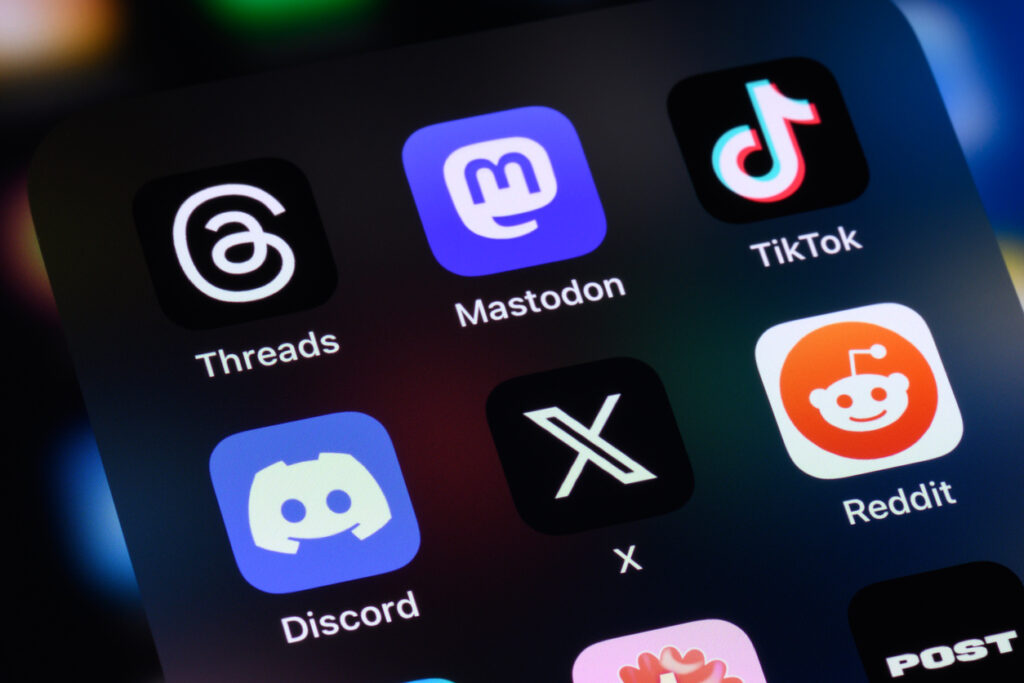We are witnessing the literal death spiral of X, formerly known as Twitter, in real time. In the face of a politically charged crisis in Israel and Gaza, X has made it harder to find content from credible journalists and easier for misinformation and propaganda to make its way to the top of feeds via the unverified blue check system.
Anyone who is still lingering on X, me included, saw a dramatic shift over the last week of people finally fleeing X. This is particularly true of media outlets and journalists. Threads, owned by Meta, seems to have been the beneficiary of the exodus, squeezing out Bluesky, which still insists on only allowing people to join with an invite link (an exception was made for journalists recently, though they will go where their audience goes).
Noting that we have been talking about the demise of Twitter/X ever since the company changed ownership, the volatility of the site (in content policies and technology) has made me and likely many of you start to question your journals’ presence on the site and the work required to maintain journal handles.

With that in mind, I was interested in an article last week about the changes in visitors to the National Public Radio (NPR) website after they left X. Spoiler alert: there were no significant changes.
While NPR’s main account had 8.7 million followers and the politics account had just under three million, “the platform’s algorithm updates made it increasingly challenging to reach active users; you often saw a near-immediate drop-off in engagement after tweeting and users rarely left the platform,” the [NPR] memo [to staff] says.
The reason this piqued my interest is because at the American Society of Clinical Oncology (ASCO) we looked at the referrals from X to the journal website over the last 3 years. To understand the significance of what the reports show, you need to understand a little bit about the ASCO Journals Twitter/X journey.
Three years ago, there was one Twitter handle for all ASCO publications. This made for a less than ideal user experience when new articles from the Journal of Clinical Oncology (JCO) were mixed in the shuffle with news articles, ASCO Educational Book reviews, etc. After working with a social strategy team, we decided to launch Twitter handles for each of the 5 journals in November of 2021. JCO inherited the followers of the previous combined Twitter handle.
Part of the strategy also included paid social marketing, entirely on Twitter. Three paid campaigns were launched — one to build awareness of the new Twitter handles, one to encourage readership, and one to encourage submissions.
We have physician social media editors that write tweets/posts for every article published. And we have a contractor that helps us to improve the posts and monitor for activity and reposting.
The short story is that staff, contractors, and volunteer editors spend a lot of time crafting ideal posts for the journal handles. Additionally, we have invested in social content including infographics and video abstracts. All of this effort begs the question of whether it worked.
There are four metrics that we have focused on:
Increase in followers of each handle: Each journal has seen increases in followers. JCO, the largest account, increased by about 43% and the other journals also increased (2 started at zero as new accounts and 2 were “reactivated” from a previous incarnation).
Altmetric scores: Still includes usage on X but not yet pulling in stats from other social networks like Mastodon, Bluesky, or Threads. For a large clinical journal like JCO, the Altmetric scores are largely driven up by news coverage of the content and not posts on X.
Engagement with the tweets via comments and retweets: We have found that readers generally do not engage with content posted on the journal handles and we have had limited success with trying things like threads and tagging thought leaders. Where the engagement with journals content happens is with organic posting — an author or collaborator or thought leader will decide to post a journal article, summarize, and offer an opinion. These posts tend to enjoy a significant amount of engagement.
Usage of the content as measured by referral stats: Here is where things get interesting. Prior to us launching our individual journal Twitter handles in November of 2021, the referrals to JCO from Twitter hovered between 1-2% of referrals. The referrals to all five JCO journals since 2021 had not changed until very recently. I’ll say that again… all the effort to craft effective tweets or posts, include images and visual content, and curate with physician editors has not increased the usage of the content directly from X. Over the last 2-3 months, we have seen a drop in X referrals.
All of this raises the question of what value we are getting from X and possibly other social platforms. If we were to stop posting content, would anyone notice?
The answer to that question depends on where your community is consuming content. As of at least a month ago, it seemed that our oncology community was still going strong on X; however, we are monitoring that closely. As has been noted elsewhere, many people “leaving” X, keep their account on X but visit the site less frequently or go from active to passive participant. This may require a switch from “referrals” to “views” in the metrics used to monitor activity.
What old Twitter called “impressions,” X now calls views. It’s hard to tell if the definition changed and you can no longer access impressions data on older tweets (seems to indicate that views are different and they just deprecated all the previous data). That said, for an average post on the JCO handle with 48,000 followers, there are now only 2,300-3,300 “views” of that post. Unless someone else with a decent following picked up the post and reposted it, only 6-7% of followers see the post.
There are many reasons someone following a handle doesn’t actually see a post — timing, the user’s desire to scroll through a feed, or the users not going to the app at all.
There are very clear advantages to community-posted journal content. And using social media to promote new initiatives of a journal also has some effectiveness. Going through the work of developing social friendly content may be of value to users who only want to consume content on social platforms. The harder tasks seem to be the community building and driving usage that we hoped to see from social media. As noted in the article about NPR:
Twitter wasn’t just about clicks. Posting was table stakes for building reputation and credibility, either as a news outlet or as an individual journalist. To be on Twitter was to be part of a conversation, and that conversation could inform stories or supply sources. This kind of connection is hard to give up, but it’s not impossible to replace.
I don’t know what all this means if we now have to pack up our Twitter/X content and move somewhere else. Journal editorial offices have been putting time and effort into building and maintaining journal social media for about a decade. If given the opportunity, will we do it all over again?
Discussion
5 Thoughts on "Worth the Time? A Critical Look at the Value of Twitter for Journals"
An insightful read – thank you Angela!
The question you have posed really resonates, and is one we are being asked often at TBI! In a recent social media audit we conducted for a US-based publisher, between March – August of this year (amidst the uncertainty), surprisingly X was the leading platform driving the greatest organic reach, suggesting the scientific community were at that stage still very much active, despite the turbulence. That’s not to say that this hasn’t dramatically changed through September and October, and no doubt we will see further changes, if and when X becomes subscription based.
In addition to building brand awareness, how much of that branding is our own brands and not Twitter’s or one of these other social media outfits? The last focus group we did on how people consumed news led to the usual suspects, Facebook, Instagram, Google News, but what didn’t come up were the places that actually did the reporting. i.e New York Times, PBS etc..
So although there can be reasons to be on social media platforms, I’m starting to think promoting content is one of those things you let your community handle, and 90% of the time, focus the publisher/societies time on finding ways to build stronger, more direct connections to our audiences. Such as that old standby: Email.
Mind you, I’m basically describing part of my job, so I’m probably speaking from a bias perspective.
Social media is essentially the cheapest form of marketing even if you are modestly boosting your content with paid advertising. It has be come the “word of mouth” marketing of modern times, which is why there is more engagement when a reader/user reposts content vs when the publisher posts the same content. Content providers (aka publishers) get reasonable value from these “endorsements” from a reader’s peers with relatively little expense with the help of automation/syndication (and now potentially AI).
My opinion is the more platforms that emerge to provide a home for Twitter/X defectors, the less valuable social media is going to become to publishers because the audience is going to be more splintered or the audience will become so overwhelmed with monitoring multiple platforms their usage will drop considerably (to some extent, I think this is already happening).
Social media can be a lot of work for publishers. Add more platforms–and platforms that don’t offer APIs to facilitate posting to multiple platforms at once–it’s going to become even more taxing. The first of these new players to offer an API is going to have a distinct advantage with content creators. The question is can we bring our followers with us? The sign up rate of Threads was impressive, but the usage didn’t follow because when these new users logged in, there wasn’t enough content to pique their interest.
There’s also the question of whether the content we’re promoting on social media has a big audience to begin with (hint: in this case, it doesn’t). Posts about niche studies in niche fields are going to reach a couple hundred people tops, and of these reaches, maybe a handful (if that) will be inspired to click through or comment.
So then, is this effort worth it? I think it depends on your goal. A lot of us here probably follow Richard Poynder on X, for example, to help stay on top of the latest news in OA. Richard has about 8k followers, but each of his posts scores maybe a couple hundred impressions tops, and maybe one comment (if that) and an occasional retweet. But that doesn’t mean it’s a losing proposition (at least from my perspective—maybe not Richard’s!). This curation service is important to me. So too, the summary/curation work being done for research papers via social media is an important service, even if its true value may be hard to measure.
On the other hand, if the goal of outreach efforts (like but not limited to social media) is to boost meaningful engagement and conversation, then yes—old school has always been where it’s at: email, listservs, newsletters, and blog posts (like right here on TSK). Your potential audience reach for these forms of outreach is way smaller, but those you do reach are way more invested and engaged.
Personally, I think there’s a need for both approaches—reaching out beyond our circles, but also really engaging with the audience inside our circles. For companies looking for other ways to expand their circles, one hybrid approach might be to invest more in the old-school conversations and engagement—take care of the base—and then promote summaries of these conversations via social media. In other words, give people a reason to engage with content, to find others who are also passionate about a subject, and to discuss topics of interest with fellow experts instead of bots. Real engagement like this doesn’t just happen. It needs to be thoughtfully cultivated. Just posting stuff on social media with a “read this” label has its place, but it doesn’t substitute for the much harder (and ultimately much more valuable and fulfilling) work of actually building a community.
I actually read the tweet about this article first on X, but got really engaged with it through the actual post. It sumarizes everything I have been thinking about it lately. Although X still remains essential for me to get a lot of info in a short time – allowing me to choose what’s worth reading – going through this post questions me on the added value of building a community on X.



